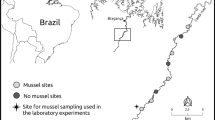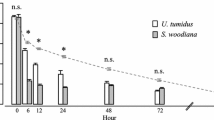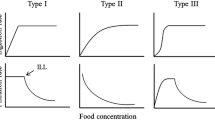Abstract
Benthic filter feeding macrofauna organisms may be an important factor linking sediment and water column. Transport of water and concomitantly of suspended matter is directly related to the size of the benthic filter feeding population. This paper aims to determine the potential for water transport by the bivalve Mya arenaria along a coastal stretch of roughly 100 km length in the southern Baltic Sea. Quantification of population filtration rates specific to the area is based on distribution, abundance and biomass of M. arenaria and calculated according to previously published filtration rate–biomass relations. Calculated rates range up to >8 m3 m−2 day−1 (at 5–20 m water depth in sandy sediment) with the potential to locally process a volume of water equivalent to the water column within <1 day. Data from 1991–2002 at one site suggest that the area-specific potential population filtration rate remains remarkably constant in time despite changes in population structure of M. arenaria. The related impact on pore water exchange within the permeable sediment associated with the leakage of water from the gape of M. arenaria valves is discussed.





Similar content being viewed by others
References
Aller RC (1977) The influence of macrobenthos on chemical diagenesis of marine sediments. PhD dissertation. Department of Geology and Geophysics, New Haven, Conn.
Aller RC (1982) The effects of macrobenthos on chemical properties of marine sediment and overlying water. In: McCall PL, Tevesz MJS (eds) Animal–sediment relations. Plenum, New York, pp 53–104
Amouroux J-M, Amouroux J, Bastide J, Cahet G (1990) Interrelations in a microcosm with a suspension-feeder and a deposit-feeder. I: experimental study. Oceanol Acta 13:61–68
Amouroux J-M, Grémare A, Cahet G (1991) Experimental study of the interactions between a natural 14C radiolabelled sediment and a deposit-feeding bivalve: Abra alba. Oceanol Acta 14:589–597
Betke D (2002) Der Einfluss von Mya arenaria auf die Sedimentchemie. Master thesis, University of Rostock, Rostock
Brenchley GA (1981) Disturbance and community structure: an experimental study of bioturbation in marine soft-bottom environments. J Mar Res 39:767–790
Cranford PJ (2001) Evaluating the ‘reliability’ of filtration rate measurements in bivalves. Mar Ecol Prog Ser 215:303–305
Darcy H (1856) Les Fontaines Publiques de la Ville de Dijon. Dalmont, Paris
Emerson CW, Grant J (1991) The control of soft-shell clam (Mya arenaria) recruitment on intertidal sandflats by bedload sediment transport. Limnol Oceanogr 36:1288–1300
Forster S (1991) Die Bedeutung biogener Strukturen für den Sauerstofffluß ins Sediment. PhD dissertation. Christian-Albrechts University, Kiel
Forster S, Bobertz B, Bohling B (2004) Permeability of sands in the coastal areas of the southern Baltic Sea: mapping a grain-size related sediment property. Aquat Geochem (in press)
Franz DR, Merrill AS (1980) Molluscan distribution patterns on the continental shelf of the Middle Atlantic Bight (northwest Atlantic). Malacologia 19:209–225
Gray JS (1981) The ecology of marine sediments. Cambridge University Press, Cambridge
Hansen K, King GM, Kristensen E (1996) Impact of the soft-shell clam Mya arenaria on sulfate reduction in an intertidal sediment. Aquat Microb Ecol 10:181–194
Henriksen K, Rasmussen MB, Jensen A (1983) Effect of bioturbation on microbial nitrogen transformations in the sediment and fluxes of ammonium and nitrate to overlaying water. Ecol Bull 35:193–205
Jaehmlich S, Thomsen L, Graf G (1999) Factors controlling aggregate formation in the benthic boundary layer of the Mecklenburg Bight (western Baltic Sea). J Sea Res 41:245–254
Jagnow B, Gosselck F (1987) Bestimmungsschlüssel für die Gehäuseschnecken und Muscheln der Ostsee. Mitt Zool Mus Berl 63:191–268
Jørgensen CB (1975) Comparative physiology of suspension feeding. Annu Rev Physiol 37:57–79
Jørgensen CB, Riisgård HU (1988) Gill pump characteristics of Mya arenaria. Mar Biol 99:107–109
Kristensen E (2001) Impact of polychaetes (Nereis spp. and Arenicola marina) on carbon biogeochemistry in coastal marine sediments. A review. Geochem Trans 2:92–104
Kube J (1996) Spatial and temporal variations in the population structure of the soft-shell clam Mya arenaria in the Pomeranian Bay (southern Baltic Sea). J Sea Res 35:335–344
Kube J, Peters C, Powilleit M (1996) Spatial variation in growth of Macoma balthica and Mya arenaria (Mollusca, Bivalvia) in relation to environmental gradients in the Pomeranian Bay (southern Baltic Sea). Arch Fish Mar Res 44:81–93
Kühl H (1981) The sandgaper Mya arenaria. In: Dankers N, Kühl H, Wolff WJ (eds) Invertebrates of the Wadden Sea. AA Balkema, Rotterdam, pp 118–119
Lambert-Jensen J (1997) Sandmuslingen, Mya arenaria’s filtration I Keringe Nor. Graesningskontrol af fytoplankton i en lavvandet fjord. Specialerapport Århus Universitet, Denmark
McDowell Capuzzo J, Sasner JJ Jr (1977) The effects of chromium on filtration rates and metabolic activity of Mytilus edulis and Mya arenaria L. In: Vernberg FJ, Calabrese A, Thurberg FP, Vernberg WB (eds) Physiological responses of marine biota to pollutants. Academic, New York, pp 225–237
Muus BJ (1967) The fauna of Danish estuaries and lagoons. Medd Komm Dan Fisk Havunders NS 5:1–316
Newell RIE, Cornwell JC, Owens MS (2002) Influence of simulated bivalve biodeposition and microphytobenthos on sediment nitrogen dynamics: a laboratory study. Limnol Oceanogr 47:1367–1379
Nichols FH (1985) Increased benthic grazing: an alternative explanation for low phytoplankton biomass in northern San Francisco Bay during the 1976–1977 drought. Estuar Coast Shelf Sci 21:379–388
Olenin S (1997) Comparative community study of the south-eastern Baltic coastal zone and the Curonian Lagoon bottom. Proceedings of the 13th BMB Symposium, Riga, Latvia, pp 153–161
O’Riordan CA, Monismith SG, Koseff JR (1995) The effect of bivalve excurrent jet dynamics on mass transfer in a benthic boundary layer. Limnol Oceanogr 40:330–344
Pelegri SP, Blackburn TH (1995) Effect of bioturbation by Nereis sp., Mya arenaria and Cerastoderma sp. on nitrification and denitrification in estuarine sediments. Ophelia 42:289–299
Rhoads DC, Boyer LF (1982) The effects of marine benthos on physical properties of sediments, a successional perspective. In: McCall PL, Tevesz MJS (eds) Animal–sediment relations. Plenum, New York, pp 3–52
Riisgård HU, Seerup DF (2004) Filtration rates of the soft clam Mya arenaria: effects of temperature and body size. Sarsia 88:416–428
Riisgård HU, Jürgensen C, Østergaard Andersen F (1996) Case study: Kertinge Nor. In: Richardson K (ed) Eutrophication in coastal marine ecosystems. American Geophysical Union, Washington
Riisgård HU, Kittner C, Seerup DF (2003) Regulation of opening state and filtration rate in filter-feeding bivalves (Cardium edule, Mytilus edulis, Mya arenaria) in response to low algal concentration. J Exp Mar Biol Ecol 284:105–127
Scapati D, Jr. (1984) Intertidal patterns of distribution in the soft-shell clam Mya arenaria (Linne) on a New Jersey tidal flat. J Shellfish Res 4:99
Strasser M (1999) Mya arenaria—an ancient invader of the North Sea coast. Helgol Meeresunters 52:3–4
Thorin S, Bourdages H, Vincent B (1998) Study of siphon activity in Mya arenaria (L.) in the intertidal zone by means of an underwater video camera. J Exp Mar Biol Ecol 224:205–224
Turnewitsch R, Graf G (2003) Variability of particulate seawater properties related to bottom mixed layer-associated internal waves in shallow water on a time scale of hours. Limnol Oceanogr 48:1254–1264
Warzocha J (1994) Spatial distribution of macrofauna in the southern Baltic in 1983. Bull Sea Fish Inst 131:47–59
Zaklan SD, Ydenberg R (1997) The body size-burial depth relationship in the infaunal clam Mya arenaria. J Exp Mar Biol Ecol 215:1–17
Zettler ML, Bönsch R, Gosselck F (2000) Verbreitung des Makrozoobenthos in der Mecklenburger Bucht (südliche Ostsee)—rezent und im historischen Vergleich. Meereswiss Ber 42. Warnemünde. Institut für Ostseeforschung Warnemünde, Rostock
Acknowledgements
We wish to thank Doreen Betke for discussions about the leaking soft shell clam and for sharing observations. Ines Glockzin and Christine Peters helped sorting many benthos samples including those with M. arenaria. H.-U. Riisgård made us aware of new results on filtration rates of M. arenaria and his constructive criticism on an earlier version improved this manuscript. We appreciate the help of two anonymous reviewers.
Author information
Authors and Affiliations
Corresponding author
Additional information
Communicated by L. Hagerman, Helsingør
Rights and permissions
About this article
Cite this article
Forster, S., Zettler, M.L. The capacity of the filter-feeding bivalve Mya arenaria L. to affect water transport in sandy beds. Marine Biology 144, 1183–1189 (2004). https://doi.org/10.1007/s00227-003-1278-2
Received:
Accepted:
Published:
Issue Date:
DOI: https://doi.org/10.1007/s00227-003-1278-2




